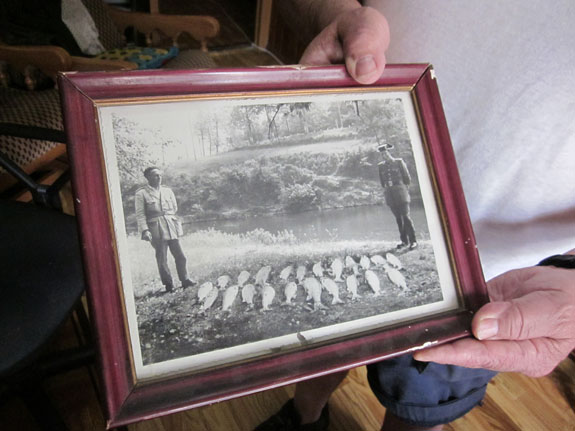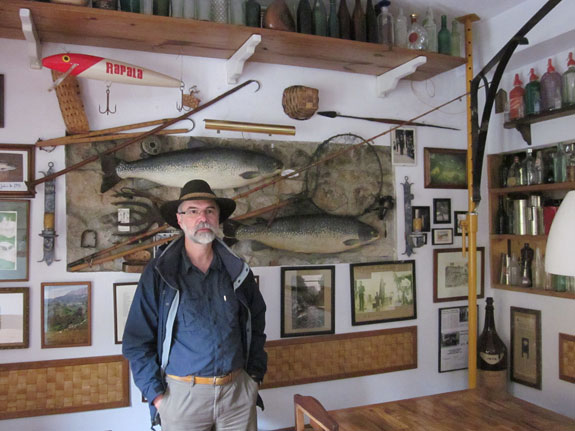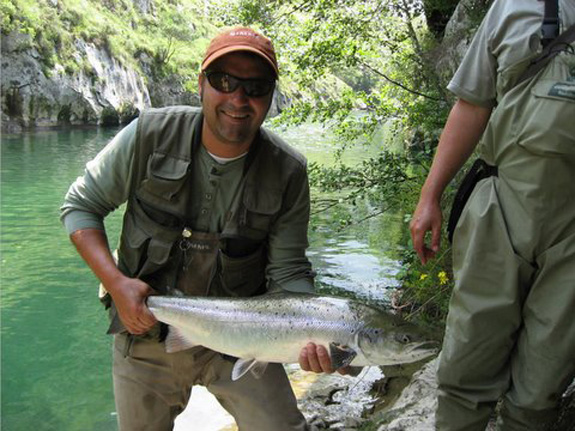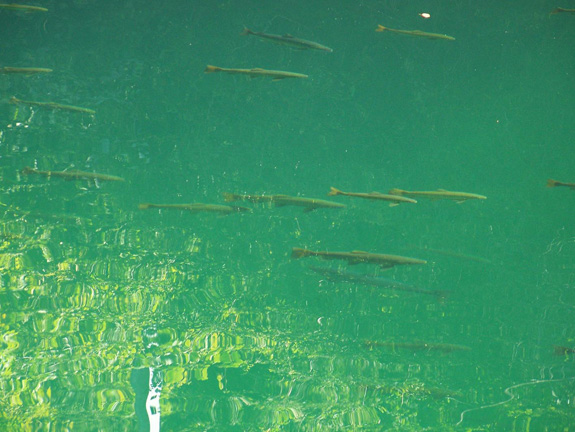Spain: Of Sun, Siestas — and Salmon?
About a dozen Spanish streams support native runs of Atlantic salmon, but anglers are deeply divided about how to fish for them
A happy fisherman holds a healthy Atlantic salmon, about to be released back into the Cares River. Most fishermen still keep such fish, a practice that some guides believe must change if the species is to survive. Photo courtesy of Luis Menendez.
“In this place, there are sometimes 100 salmon at a time,” says Luis Menendez to me as we stand side by side on a bridge over a deep green pool on the Cares River in Niserias, a five-building cluster of old bars and a hotel, just across from a famed fish ladder and only miles downstream of the huge summits and canyons of the Picos de Europa. Menendez is a local lifelong fisherman and a professional fly fishing guide. Born in the nearby cider-making town of Nava, Menendez knows the sight of a stream full of 10-, 15- and 20-pound salmon. But on this drizzling afternoon, we see none—and it’s a safe bet that there are no salmon in the pool at all, for this spring’s return of fish has been a poor one compared to historical returns. We take a drive along the river, canyon walls to either side, and pass through the thriving mountaineers’ and hikers’ town of Las Arenas. Menendez rolls down the window to call over a friend. He asks if he has heard of any salmon recently caught.
“None,” the man says.
That, Menendez says as we drive on, is one of the best fishermen in the area and was once one of the best known professionals, on whom local restaurants could often depend for a fresh salmon before the government banned the sale of river-caught fish about 10 years ago. Now, about the only way to taste Spanish salmon is to buy a fishing license and catch one.
The Cares River isn’t the only salmon stream of Spain. Another dozen or so rivers that run into the sea along the northern Spanish coast support native runs of Atlantic salmon, or Salmo salar. The species also spawns in rivers on the East Coast of America and Northern Europe. It is most commonly encountered as the product of aquatic factory farms in Scotland, Norway and Canada, but—surprise it may be to the uninitiated—it is also a famed resident of Asturias, Cantabria and Galicia. Local lore tells of the days when General Francisco Franco vacationed here, waded these streams and pulled out three-footers. Photos can be found, too, showing the general with trophies bound for the grill. Other black-and-white images show fishermen in the early 20th century with an afternoon’s catch of more salmon than most Spanish anglers today could hope to catch in a lifetime.

Local warden Jaime De Diego shows a photo of his father and a friend after a day of fishing on the Sella River in the 1950s. Such catches were usually sold to fish markets. Photo by Alastair Bland.
Today, the salmon’s numbers are declining, and Menendez is concerned about the future of the fish. Menendez advocates catch and release—”pesca sin muerte”—and requires his clients to put their salmon back, but catching fish at all this season hasn’t been easy. The health of the fishery is gauged largely by the mandatory reports to the local fisheries office from anglers who catch, and keep, a salmon. As of June 16, anglers had reported only 245 salmon from the Sella River, the most important salmon stream in Spain, and just 208 salmon from the Narcea. Though a jump from recent poor years, these numbers are still way down from historical figures. Jaime de Diego, head warden of the forests and streams of Asturias, met with me at his family’s riverside hotel, La Salmonera, and told me that in 1959 fishermen took 2,781 salmon from the Sella. In 1968, 2,090 salmon were taken and in 1970, 1,800.
2010 was a disaster, with the Asturias total topping out at 247 salmon caught and killed. This year, as of June 16, in every salmon stream in Asturias (there are a handful), 748 salmon had been caught, kept and reported (released salmon are not reported).
Menendez says there are several reasons for the decline. For one, he tells me, cormorants have expanded their range in the last decade, their population responding to the artificial food supply produced by the salmon farming operations of Norway. The birds have moved into northern Spain, he says, where they find salmon juveniles to be easy prey in the small and shallow rivers.
Cheese production is another issue, especially in the Cares-Deva drainage. In the green alpine hills above the fishing pools where the fishermen tiptoe over the boulders, herds of goats, sheep and cows graze the slopes. They wade in the streams, Menendez explains, crushing beds of fertilized fish eggs and dousing them with the toxins of their excrement. (We are all the while nibbling and praising a strong and faintly-veined blue cheese, produced by these salmon-stomping grazers.)

In the Solera del Salmon Bar in Niserias, fishing guide Luis Menendez stands before two large salmon caught and mounted years ago. Such large salmon are becoming less common in the rivers of Asturias. Photo by Alastair Bland.
Another cause of the decline is the catch of adult salmon at sea by commercial fishermen, locals tell me. De Diego says Japanese fleets are the main culprits—but another fishing tour guide, George Luis Chang of Pesca Travel, a fishing tour company that leads fishing trips throughout Spain, says commercial fishermen have been selected as a scapegoat for Spain’s salmon decline. Chang says he recognizes that catch-and-kill sport fishing itself has an effect on fish populations—but not all sport fishermen are willing to accept such a viewpoint, Chang says. When the Asturias government decided to limit anglers to three salmon in a season after the 2010 return, many local anglers were outraged, he says (Chang was in full support). Then, following a turnover in local government offices in 2011, the new three-fish limit was scrapped—and boosted to 35.
And so, Chang says, “most salmon fishermen in Asturias are happy again, but they probably don’t realize that all the salmon caught and killed this season are just hastening the decline of salmon fishing in Asturias for the years to come.” He says stocks are so low that just a few hundred salmon killed will heavily dent the genetic stock of the local runs. Chang, like Menendez, wants salmon sport fishing to continue here, but the killing to stop. So does another experienced guide, Jose Carlos Rodriguez, who lives in the coastal town of Gijon. He says most fishermen in Asturias—especially older ones—are opposed to mandatory catch-and-release policies. Traditional practice is to catch and eat, and old customs die hard among the veterans of the local river fishing culture. Rodriguez says the tourists he guides from abroad—British, French, Scandinavian and American—have largely adopted catch-and-release ethics, but until the local populace does so, it will mean a death rate in the local salmon populations that may be unsustainable.
“It is very difficult to make the older fishermen understand this,” Rodriquez says. “But the future of fishing here, and in other parts of the world, depends on catching and releasing.”
Menendez and I drive further along the Cares River, upstream of its confluence with the Deva, and we see cars are parked along the highway.
“Pescadores,” Menendez says. It’s a Saturday, and the anglers are out in force—all pursuing a handful of salmon. It’s a predator-prey balance precariously top-heavy. Just 98 salmon had been reported from the Cares-Deva system as of June 16, and surely hundreds of fishermen are working the waters each week. I would spend several days riding my bike along the rivers of the area. In one pool in the Sella, by the Salmonera Hotel, I saw just three adult salmon—and that’s it.
Meanwhile, scientists are on the case to understand, and hopefully solve, the problems in Spain’s salmon streams. Franco, in fact, was a conservationist and scientist who implemented a monitoring program of salmon caught in the Ason River of Cantabria. Comparing data of today to Franco’s time, scientists have observed that returning adults (which don’t die after spawning as do the five main Pacific salmon species) are on average smaller than in the past. De Diego believes that the reason for the size decline is that the fish are younger on average today, and instead of returning a half dozen times—larger and heavier at each reappearance—they now can manage only two or three spawning runs, then die, killed by the pollutants in the rivers.
But unfurling dramas in other European salmon rivers indicate that there is hope for the salmon of Spain. Atlantic salmon stopped returning to the Seine about a hundred years ago—but they’re back, returning in annual droves past the Eiffel Tower and under the famed bridges, in waters that for decades were too putrid for nearly any fish to live in. Hundreds of salmon have been returning each of the past several years. A similar rebound has occurred in the Rhine of Germany, reminding us that salmon are among the simplest of nature’s miracles; give them a clean river, keep out the cows and hold back the goats, and the fish will come back.
Fishing guide Luis Menendez can be contacted by email at [email protected].
Fishing guide Jose Carlos Rodriguez can be contacted on the web.
/https://tf-cmsv2-smithsonianmag-media.s3.amazonaws.com/accounts/headshot/Off-Road-alastair-bland-240.jpg)


/https://tf-cmsv2-smithsonianmag-media.s3.amazonaws.com/accounts/headshot/Off-Road-alastair-bland-240.jpg)